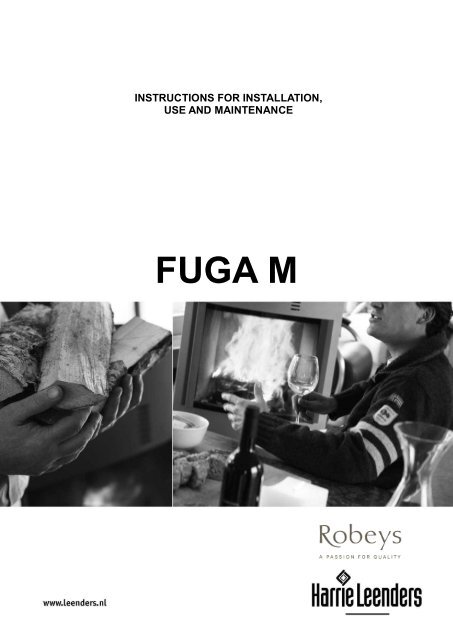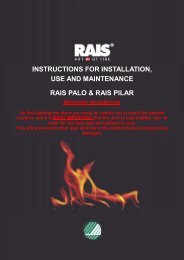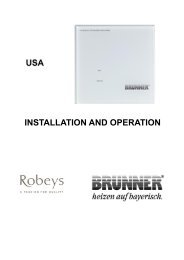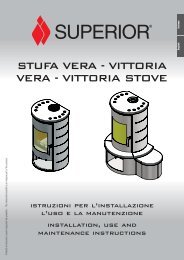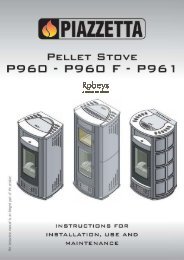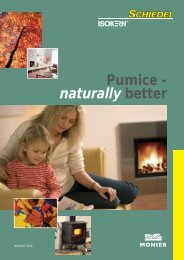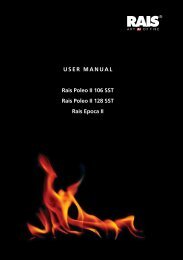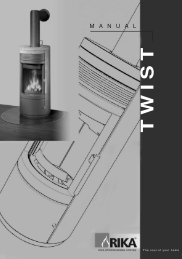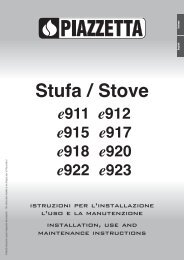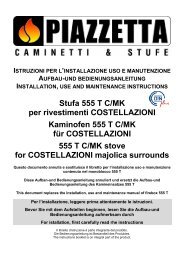Harrie Leenders Fuga M Installation, Use and ... - Robeys Ltd
Harrie Leenders Fuga M Installation, Use and ... - Robeys Ltd
Harrie Leenders Fuga M Installation, Use and ... - Robeys Ltd
You also want an ePaper? Increase the reach of your titles
YUMPU automatically turns print PDFs into web optimized ePapers that Google loves.
<strong>Harrie</strong> <strong>Leenders</strong> <strong>Fuga</strong> M Instructions for <strong>Installation</strong>, <strong>Use</strong> <strong>and</strong> MaintenanceINSTRUCTIONS FOR INSTALLATION,USE AND MAINTENANCEFUGA M1
<strong>Harrie</strong> <strong>Leenders</strong> <strong>Fuga</strong> M Instructions for <strong>Installation</strong>, <strong>Use</strong> <strong>and</strong> Maintenance2
<strong>Harrie</strong> <strong>Leenders</strong> <strong>Fuga</strong> M Instructions for <strong>Installation</strong>, <strong>Use</strong> <strong>and</strong> MaintenanceGeneral instructions <strong>and</strong> regulationsMaintenance ………………………………………………………….. 6Service ………………………………………………………………… 6Declaration ……………………………………………………………. 6Characteristics report ………………………………………………... 6Description of the <strong>Fuga</strong> M ………………………………………...… 6HETAS supplementHealth <strong>and</strong> Safety precautions …………..…………………………. 7Chimney ……………………………………………………………….. 8Hearth …………………………………………………………………. 9Combustion air supply ……………………………………………….. 9Connection to chimney …………………………………………….... 9Commissioning <strong>and</strong> h<strong>and</strong>over ……………………………………… 9ManualWhat you should know about the <strong>Fuga</strong> M ………………………… 10The three basic rules for proper burning ………………………….. 10Warning note …………………………………………………………. 11Important notes ………………………………………………………. 11<strong>Use</strong>r operating instructions …………………………………………. 12The fine heat from wood …………………………………………….. 13Initial fireup, a good start …………………………………………… 13Initial fireup in steps …………………………………………………. 14How to use the <strong>Fuga</strong> M …………………………………………..… 15The power of fire ……………………………………………………… 16A few tips ……………………………………………………………… 16MaintenanceCeramic firebricks ……………………………………………………. 17Glass ………………………………………………………………….. 17Moving parts ………………………………………………………….. 17Collecting soot when sweeping the chimney ……………………… 18<strong>Installation</strong> instructions<strong>Fuga</strong> M specifications ……………………………………..………… 19General instructions <strong>and</strong> regulations ………………………………. 20Safety recommendations ……………………………………………. 20Materials <strong>and</strong> tools required ………………………………………… 20<strong>Installation</strong> diagrams ………………………………………………… 21 / 233
<strong>Harrie</strong> <strong>Leenders</strong> <strong>Fuga</strong> M Instructions for <strong>Installation</strong>, <strong>Use</strong> <strong>and</strong> Maintenance1. Door2. Ceramic glass3. Aeration slide4. Base5. Convection pipes6. Convection fins7. Door h<strong>and</strong>le8. Smoke baffle plate4
<strong>Harrie</strong> <strong>Leenders</strong> <strong>Fuga</strong> M Instructions for <strong>Installation</strong>, <strong>Use</strong> <strong>and</strong> MaintenanceDimensions in mm5
<strong>Harrie</strong> <strong>Leenders</strong> <strong>Fuga</strong> M Instructions for <strong>Installation</strong>, <strong>Use</strong> <strong>and</strong> MaintenanceGeneral instructions <strong>and</strong> regulationsMaintenanceHave the appliance serviced regularly by a qualified technician.Ensure that the fluegas connection <strong>and</strong> the chimney are cleaned regularly.Check to ensure that the chimney is still open before lighting the stove again if it has not beenused for an extended period of time.If, in spite of the precautions taken, there should occur a chimney fire (usuallyaccompanied by a roaring noise in the chimney), proceed as follows:Shut off the air supply <strong>and</strong> close the door of the stove immediatelyCall the fire brigadeQuickly extinguish the fire in the stove with s<strong>and</strong> to prevent smoke from getting into your houseVentilate the houseNever use water to extinguish the fireEnsure that after a fire the chimney is first swept <strong>and</strong> inspected for any damage <strong>and</strong> leaks.ServiceIt is not allowed to make any modifications to the appliance without prior authorization of themanufacturer.Only use replacement parts recommended by the manufacturer.DeclarationThe undersigned, representing the following:<strong>Harrie</strong> <strong>Leenders</strong> Haardkachels, Industrieweg 25, 5688 DP, Oirschot, Nederl<strong>and</strong>herewith declare that the product <strong>Fuga</strong> M is in conformity with the provisions of the following ECDirectives when installed in accordance with the installation instructions contained in the productdocumentation: EN 13240:2001/A2:2004 (E) "Roomheaters fired by solid fuel"Product: Roomheaters fired by solid fuels as covered under the scope of this st<strong>and</strong>ard intendeduse: Space heating in residential buildings.Characteristics ReportFire safetyEmission of combustion productsRelease of dangerous substanceSurface temperatureMechanical resistance (to carry a chimney / flue)Thermal output / energy efficiency2005PMC/122005PMC/122005PMC/122005PMC/122005PMC/122005PMC/12Description of the room heater <strong>Fuga</strong> M:Wood stove made of sheet metal. The stove is designed to be installed on the wall. It is providedwith a selfclosing window door, fixed secondary air supply <strong>and</strong> controllable air wash airsupply. The combustion chamber is insulated with refractory ceramic elements. The fluegasconnection is located at the top of the appliance.Notified body:Report number:Manufacturer:SGS Environmental Services, Postbus 5252, 6802 EG Arnhem2005PMC/12<strong>Harrie</strong> <strong>Leenders</strong> HaardkachelsName: Bart <strong>Leenders</strong>Position: General ManagerDate: 150720056
<strong>Harrie</strong> <strong>Leenders</strong> <strong>Fuga</strong> M Instructions for <strong>Installation</strong>, <strong>Use</strong> <strong>and</strong> MaintenanceREAD THE INSTRUCTION BOOKLET AND THESE SUPPLEMENTARYINSTRUCTIONS CAREFULLY BEFORE INSTALLATIONThese instructions together with those in the instruction booklet cover the basic principlesto ensure the satisfactory installation of the stove, although detail may need slightmodification to suit particular local site conditions.In all cases the installation must comply with current Building Regulations, Local AuthorityByelaws <strong>and</strong> other specifications or regulations as they affect the installation of the stove.It should be noted that the Building Regulations requirements may be met by adopting therelevant recommendations given in British St<strong>and</strong>ards BS 8303, BS EN 152871:2007 as analternative means to achieve an equivalent level of performance to that obtained followingthe guidance given in Approved Document J.Please note that it is a legal requirement under Engl<strong>and</strong> <strong>and</strong> Wales Building Regulationsthat the installation of the stove is either carried out under Local Authority BuildingControl approval or is installed by a Competent Person registered with a Governmentapproved Competent Persons Scheme. HETAS <strong>Ltd</strong> operate such a Scheme <strong>and</strong> a listing oftheir Registered Competent Persons can be found on their website at www.hetas.co.uk.CO Alarms:Building regulations require that when ever a new or replacement fixed solid fuel or wood/biomass appliance is installed in a dwelling a carbon monoxide alarm must be fitted in thesame room as the appliance. Further guidance on the installation of the carbon monoxidealarm is available in BS EN 50292:2002 <strong>and</strong> from the alarm manufacturer’s instructions.Provision of an alarm must not be considered a substitute for either installing theappliance correctly or ensuring regular servicing <strong>and</strong> maintenance of the appliance <strong>and</strong>chimney system.HEALTH AND SAFETY PRECAUTIONSSpecial care must be taken when installing the stove such that the requirements of the Health <strong>and</strong> Safety atWork Act are met.H<strong>and</strong>lingAdequate facilities must be available for loading, unloading <strong>and</strong> site h<strong>and</strong>ling.Fire CementSome types of fire cement are caustic <strong>and</strong> should not be allowed to come into contact with the skin. Incase of contact wash immediately with plenty of water.AsbestosThis stove contains no asbestos. If there is a possibility of disturbing any asbestos in the course of installationthen please seek specialist guidance <strong>and</strong> use appropriate protective equipment.Metal PartsWhen installing or servicing this stove care should be taken to avoid the possibility of personal injury.STOVE PERFORMANCEPlease refer to the table in the main instruction manual for details of the stoves’ performances7
<strong>Harrie</strong> <strong>Leenders</strong> <strong>Fuga</strong> M Instructions for <strong>Installation</strong>, <strong>Use</strong> <strong>and</strong> MaintenancePREPARATORY WORK AND SAFETY CHECKSIMPORTANT WARNINGThis stove must not be installed into a chimney that serves any other heating appliance.There must not be an extractor fan fitted in the same room as the stove as this can cause the stove to emitfumes into the room.ChimneyIn order for the stove to perform satisfactorily the chimney height must be sufficient to ensure an adequatedraught of approximately 15 Pa so as to clear the products of combustion <strong>and</strong> prevent smoke problems intothe room.NOTE: A chimney height of not less than 4.5 metres measured vertically from the outlet of the stove to thetop of the chimney should be satisfactory. Alternatively the calculation procedure given in EN 133841 maybe used as the basis for deciding whether a particular chimney design will provide sufficient draught.The outlet from the chimney should be above the roof of the building in accordance with the provisions ofBuilding Regulations Approved Document J.If installation is into an existing chimney then it must be sound <strong>and</strong> have no cracks or other faults whichmight allow fumes into the house. Older properties, especially, may have chimney faults or the cross sectionmay be too large i.e. more than 230 mm x 230 mm. Remedial action should be taken, if required, seekingexpert advice, if necessary. If it is found necessary to line the chimney then a flue liner suitable for solidfuel must be used in accordance with Building Regulations Approved Document J.Any existing chimney must be clear of obstruction <strong>and</strong> have been swept clean immediately before installationof the stove. If the stove is fitted in place of an open fire then the chimney should be swept one monthafter installation to clear any soot falls which may have occurred due to the difference in combustion betweenthe stove <strong>and</strong> the open fire.If there is no existing chimney then any new system must be to the designation described above <strong>and</strong> in accordancewith Building Regulations Approved Document J.A single wall metal fluepipe is suitable for connecting the stove to the chimney but is not suitable for use asthe complete chimney. The chimney <strong>and</strong> connecting fluepipe must have a minimum diameter of 150 mm<strong>and</strong> its dimension should be not less than the size of the outlet socket of the stove.Any bend in the chimney or connecting fluepipe should not exceed 45°. 90° bends should not be used.Combustible material should not be located where the heat dissipating through the walls of fireplaces orflues could ignite it. Therefore when installing the stove in the presence of combustible materials due accountmust be taken of the guidance on the separation of combustible material given in Building RegulationsApproved Document J <strong>and</strong> also in these stove instructions.If it is found that there is excessive draught in the chimney then a draught stabiliser should be fitted. Fittingof a draught stabiliser will affect the requirement for the permanent air supply into the room in which thestove is fitted in accordance with Approved Document J (see also combustion air supply).Adequate provision e.g. easily accessible soot door or doors must be provided for sweeping the chimney<strong>and</strong> connecting fluepipe where it is not intended for the chimney to be swept through the appliance.8
<strong>Harrie</strong> <strong>Leenders</strong> <strong>Fuga</strong> M Instructions for <strong>Installation</strong>, <strong>Use</strong> <strong>and</strong> MaintenanceHearthThe hearth should be able to accommodate the weight of the stove <strong>and</strong> its chimney if the chimney is notindependently supported. The weight of the stove is indicated in the brochure.The stove should preferably be installed on a noncombustible hearth of a size <strong>and</strong> construction that is inaccordance with the provisions of the current Building Regulations Approved Document J.The clearance distances to combustible material beneath, surrounding or upon the hearth <strong>and</strong> walls adjacentto the hearth should comply with the guidance on the separation of combustible material given inBuilding Regulations Approved Document J <strong>and</strong> also in these stove instructions.If the stove is to be installed on a combustible floor surface, it must be covered with a noncombustible materialat least 12mm thick, in accordance with Building Regulations Approved Document J, to a distance of30 cm in front of the stove <strong>and</strong> 15 cm to each side measuring from the door of the combustion chamber.Combustion air supplyIn order for the stove to perform efficiently <strong>and</strong> safely there must be an adequate air supply into the room inwhich the stove is installed to provide combustion air. The provision of air supply to the stove must be inaccordance with current Building Regulations Approved Document J. An opening window is not appropriatefor this purpose.Connection to chimneyStoves may have a choice of either a rear or top flue gas connector that allows connection to either a masonrychimney or a prefabricated factory made insulated metal chimney in accordance with their instructions.In some cases it may be necessary to fit an adaptor to increase the diameter of the flue to the minimumrequired 150 mm section of the chimney or liner.Commissioning <strong>and</strong> h<strong>and</strong>overEnsure all parts are fitted in accordance with the instructions.On completion of the installation allow a suitable period of time for any fire cement <strong>and</strong> mortar to dry out,before lighting the stove. Once the stove is under fire check all seals for soundness <strong>and</strong> check that the flueis functioning correctly <strong>and</strong> that all products of combustion are vented safely to atmosphere via the chimneyterminal.On completion of the installation <strong>and</strong> commissioning ensure that the operating instructions for the stove areleft with the customer. Ensure to advise the customer on the correct use of the appliance <strong>and</strong> warn them touse only the recommended fuel for the stove.Advise the user what to do should smoke or fumes be emitted from the stove. The customer should bewarned to use a fireguard to BS 8423:2002 (Replaces BS 6539) in the presence of children, aged <strong>and</strong>/orinfirm persons.9
Manual<strong>Harrie</strong> <strong>Leenders</strong> <strong>Fuga</strong> M Instructions for <strong>Installation</strong>, <strong>Use</strong> <strong>and</strong> MaintenanceWe congratulate you on the purchase of your stove. This manual will inform you aboutthe best way of using the stove <strong>and</strong> the art of keeping a perfect fire. Before using thestove, carefully read the text about breaking in the stove.These heating instructions apply to the <strong>Fuga</strong> M. They are merely intended as a guidelineas your stove will behave differently according to the place where it is installed, simplybecause the conditions are different. The flue, the weather, the quality of the wood used<strong>and</strong> the climate conditions in the house determine your stove's burning behaviour. In timeyou will develop your own directions for use, based on these heating instructions.What you should know about the <strong>Fuga</strong> MThe <strong>Fuga</strong> M is a radiant stove with convection which, when the stove is burning properly,ensures a fine heat distribution.The burning chamber is lined inside with highgrade ceramic firebrick elements (prisolith).The aeration slide is opened by pulling it outwards (kindling position).You open the door on the right side of the stove.The three basic rules for proper burning are:1 <strong>Use</strong> dry <strong>and</strong> clean wood.The stove is suitable for burning socalled 'stackable fuels': wood <strong>and</strong> briquettes. Weassume you will be using dry fuels only. So, this also holds for the kindling paper <strong>and</strong>cardboard. Wet fuel costs more energy, leaves moisture on the glass <strong>and</strong> soils the flue.2 Do not temper the burning process excessively.Allow the stove sufficient time to warm up (stay with it at this stage) <strong>and</strong> do not temperthe fire too quickly. Bear this rule in mind: you must not temper a stove until it haswarmed up properly.3 Always make sure there is enough fresh air.In houses today, cracks <strong>and</strong> gaps have often been sealed. Opening a small grate orcantilever window will ensure sufficient fresh air, provided no freshairsupply system isused.The main thing when making the fire is that both the flue <strong>and</strong> the stove reach the propertemperature.Each time you want to open the stove when burning, the aircontrol slide must be open(completely pulled out) to ensure proper air supply.10
<strong>Harrie</strong> <strong>Leenders</strong> <strong>Fuga</strong> M Instructions for <strong>Installation</strong>, <strong>Use</strong> <strong>and</strong> MaintenanceREAD THE INSTRUCTION BOOK AND THESE INSTRUCTIONS CAREFULLYBEFORE USING THE STOVEWARNING NOTEProperly installed, operated <strong>and</strong> maintained this stove will not emit fumes into the dwelling. Occasional fumesfrom de‐ashing <strong>and</strong> re‐fuelling may occur. However, persistent fume emission is potentially dangerous <strong>and</strong>must not be tolerated. If fume emission does persist, then the following immediate action should be taken:‐(a) Open doors <strong>and</strong> windows to ventilate the room <strong>and</strong> then leave the premises.(b) Let the fire go out.(c) Check for flue or chimney blockage <strong>and</strong> clean if required(d) Do not attempt to relight the fire until the cause of the fume emission has been identified <strong>and</strong> corrected.If necessary seek expert advice.The most common cause of fume emission is flue way or chimney blockage. For your own safety thesemust be kept clean at all times.IMPORTANT NOTESGeneralBefore lighting the stove check with the installer that the installation work <strong>and</strong> commissioning checks describedabove have been carried out correctly <strong>and</strong> that the chimney has been swept clean, is sound <strong>and</strong>free from any obstructions. As part of the stoves’ commissioning <strong>and</strong> h<strong>and</strong>over the installer should haveshown you how to operate the stove correctly.CO AlarmYour installer should have fitted a CO alarm in the same room as the appliance. If the alarm sounds unexpectedly,follow the instructions given under “Warning Note” above.<strong>Use</strong> of fireguardWhen using the stove in situations where children, aged <strong>and</strong>/or infirm persons are present a fireguard mustbe used to prevent accidental contact with the stove. The fireguard should be manufactured in accordancewith BS 8423:2002 (Replaces BS 6539).Chimney cleaningThe chimney should be swept at least twice a year. It is important that the flue connection <strong>and</strong> chimney areswept prior to lighting up after a prolonged shutdown period.If the stove is fitted in place of an open fire then the chimney will require sweeping after a month of continuousoperation. This is a precaution to ensure that any “softer” deposits left from the open fire usage have not beenloosened by the higher flue temperatures generated by the closed stove.In situations where it is not possible to sweep through the stove the installer will have provided alternativemeans, such as a soot door. After sweeping the chimney the stove flue outlet <strong>and</strong> the flue pipe connectingthe stove to the chimney must be cleaned with a flue brush.11
<strong>Harrie</strong> <strong>Leenders</strong> <strong>Fuga</strong> M Instructions for <strong>Installation</strong>, <strong>Use</strong> <strong>and</strong> MaintenancePeriods of Prolonged Non<strong>Use</strong>If the stove is to be left unused for a prolonged period of time then it should be given a thorough clean toremove ash <strong>and</strong> unburned fuel residues. To enable a good flow of air through the appliance to reduce condensation<strong>and</strong> subsequent damage, leave the air controls fully open.Extractor fanThere must not be an extractor fan fitted in the same room as the stove as this can cause the stove to emitsmoke <strong>and</strong> fumes into the room.Aerosol spraysDo not use an aerosol spray on or near the stove when it is alight.<strong>Use</strong> of operating toolsAlways use the operating tools provided when h<strong>and</strong>ling parts likely to be hot when the stove is in use.Chimney FiresIf the chimney is thoroughly <strong>and</strong> regularly swept, chimney fires should not occur. However, if a chimney firedoes occur turn off the stove immediately <strong>and</strong> isolate the mains electricity supply (if applicable), <strong>and</strong> tightlyclose the doors of the stove. This should cause the chimney fire to go out. If the chimney fire does not goout when the above action is taken then the fire brigade should be called immediately. Do not relight thestove until the chimney <strong>and</strong> flue ways have been cleaned <strong>and</strong> examined by a professional.Permanent air ventThe stove requires a permanent <strong>and</strong> adequate air supply in order for it to operate safely <strong>and</strong> efficiently.In accordance with current Building Regulations the installer may have fitted a permanent air supply ventinto the room in which the stove is installed to provide combustion air. This air vent should not under anycircumstances be shut off or sealed.USER OPERATING INSTRUCTIONSRecommended fuelsStoves may be designed to burn dry seasoned wood logs <strong>and</strong>/or solid mineral fuel as indicated in the mainstove manuals.HETAS <strong>Ltd</strong> ApprovalHETAS approval may be limited to specific fuel types as detailed in the main instruction manuals. Approvaldoes not cover the use of other fuels either alone or mixed with the recommended fuel, nor does it coverinstructions for the use of other fuels.12
<strong>Harrie</strong> <strong>Leenders</strong> <strong>Fuga</strong> M Instructions for <strong>Installation</strong>, <strong>Use</strong> <strong>and</strong> MaintenanceInitial fireup, a good startYou have purchased a br<strong>and</strong>new stove, 'zero on the meter', has not seen a flame yet.This means you are going to take care of the initial 'miles'. The ceramic firebricks will startevaporating moisture <strong>and</strong> your woodburning stove will start setting. For this reason, thefirst few times, do not make your fire too hot because otherwise the bricks could crack.You need not worry about any shrinkage cracks.The initial fireup requires some additional time <strong>and</strong> attention, as well as the approach wehave outlined below for you in steps. Before starting, please note the following importantpoints:When starting the fire in the stove, open the aeration slide. (This is the kindlingposition.)You can properly control the fire with the aeration slide. The further the slide isopened, the more vigorously your fire will burn.Make sure there is sufficient ventilation.13
<strong>Harrie</strong> <strong>Leenders</strong> <strong>Fuga</strong> M Instructions for <strong>Installation</strong>, <strong>Use</strong> <strong>and</strong> MaintenanceInitial fireup in steps1. Open the air slide completely by pulling it towards the front of thestove. This is the kindling position.2. Light a large ball of dry paper against the back plate of the burningchamber <strong>and</strong> allow this fire to go out again.3. Fill the stove with a h<strong>and</strong>ful of dry <strong>and</strong> thin kindling wood <strong>and</strong> light it.When it burns properly, close the air slide a bit by pushing itinwards.Stir up the fire off <strong>and</strong> on by setting the door ajar for just a momenteach time.4. Allow the fire to burn up <strong>and</strong> the stove to cool off for an hour so thatthe moisture in the firebrick can evaporate. Some liquid might comefree from the ceramic firebrick. Therefore place an old towelunderneath the stove before firingup5. After an hour, you will start bringing the entire stove to the propertemperature using first some thin kindling wood.<strong>Use</strong> the kindling position of the air slide until the fire burnsproperly.6. Then use thicker logs, ± 5x5 cm thick <strong>and</strong> 20 cm long. At the sametime, leave the aeration slide open. Close it a little bit when the fire isburning properly.14
<strong>Harrie</strong> <strong>Leenders</strong> <strong>Fuga</strong> M Instructions for <strong>Installation</strong>, <strong>Use</strong> <strong>and</strong> MaintenanceHow to use the <strong>Fuga</strong> M1. Fully open the aircontrol slide by moving it towards the front of thestove. This is the kindling position.2. Place 3 fairly thick logs on the bottom of the stove. Stack some kindlingwood on top of them. Stack lightly.Light the kindling wood up in the stove with a firelighter or some paper.Allow some time for the stove to heat up in order to ensure a properdraught <strong>and</strong> a good fire under the more solid logs to be added.3. When the stove has been burning properly for a while, add a fewmore solid logs. (First open the aeration slide.)Stack lightly. The amount (not more than 3 logs) depends on the heatrequired.4. A quietly burning fire is obtained by closing the air slide even moreby pushing it inwards. This will reduce the draught in the <strong>Fuga</strong> M. For aglowing mass of charcoal, you may close the air slide even further. Theheat will then last longer. When you want to let the fire die down, youmust open the air slide more.15
<strong>Harrie</strong> <strong>Leenders</strong> <strong>Fuga</strong> M Instructions for <strong>Installation</strong>, <strong>Use</strong> <strong>and</strong> MaintenanceThe power of fireAs a matter of fact just a few things withst<strong>and</strong> a real hot fire. Your fireplace can also bedamaged by overheating.Just to prevent this, take account of not burning more than 3,5 kilograms of wood at thesame time. 3,5 Kilograms is approximately equal to 3,5 large logs; oak with 15%moisture. The construction <strong>and</strong> the materials used from the fireplace are chosen tocontrol <strong>and</strong> resist a fire in a considered way. So heat with consideration.A few tipsMake the fire always on a bed of ash. This is an insulating layer for the fire <strong>and</strong> anexcellent bed for the fuel.If the <strong>Fuga</strong> M is overloaded with too much wood <strong>and</strong> the maximum amount of oxygen issupplied (which happens when the air slide is fully open), the fire may 'run wild'. If thisshould occur, close air slide by pushing it inwards. Never in such case leave the fireplaceunattended.You also control the temperature by the amount <strong>and</strong> kind of fuel used for each load.Remove excess ashes using a shovel or an ash cleaner. Never remove ashes using avacuum cleaner because fire may still continue to smoulder for days. Make sure youleave a layer of ashes (± 3 cm) for the next fire to be made.When the weather is foggy, preheat the flue prior to lighting your fire..16
<strong>Harrie</strong> <strong>Leenders</strong> <strong>Fuga</strong> M Instructions for <strong>Installation</strong>, <strong>Use</strong> <strong>and</strong> MaintenanceMaintenanceMaintenanceMaintenanceDust the stove using a nonfibrous cloth.Damaged spots can be touched up using an abrasive cloth <strong>and</strong><strong>Leenders</strong> stove paint. Ask you supplier for advice<strong>Harrie</strong>Maintenance ceramic firebricksYou need not worry about any cracks in the ceramic firebrick elementsas long as the flame does not come into direct contact with the metalbehind them.GlassThe glass can steam up when burning wet fuel or too little oxygen issupplied. Also, the glass may steam up if the fire does not start fiercelyenough. This happens, for instance, when you start with small logsinstead of thin kindling wood. Moisture will then remain in the fireplacefor too long, <strong>and</strong> will settle on the coldest part: the glass.Light moisture:<strong>Use</strong> paper towel <strong>and</strong> then remove the light moisture using a damp cloth.Counter pressure a little at the outside so that the glass panel does notmove.Thicker deposits:These can be treated with special fireplace glass cleaner (this can alsobe done with a piece of moist paper towel <strong>and</strong> white ash). Allow amoment for this to have its effect. Always make sure that these agentsdo not come into contact with the painted surfaces in order to preventstains from being formed.Moving partsMoving <strong>and</strong> squeaking parts can be lubricated using graphite grease.Ask your supplier for advice.17
<strong>Harrie</strong> <strong>Leenders</strong> <strong>Fuga</strong> M Instructions for <strong>Installation</strong>, <strong>Use</strong> <strong>and</strong> MaintenanceCollecting soot when sweeping the chimneyThe refractoryboard baffle <strong>and</strong> steel baffle must be removed so thatthe soot being removed during chimney sweeping will l<strong>and</strong> at thebottom of the stove.1. Slightly lift the ceramic baffle <strong>and</strong> pull it towards you. You can thentake it out easily. Then lift the steel baffle to remove it.2. Place a newspaper on the bottom of the stove to collect theaccumulated soot. Close the door <strong>and</strong> the aircontrol slide.After sweeping the chimney, remove the accumulated soot from thestove <strong>and</strong> put the refractory baffle <strong>and</strong> the steel baffle back in theirrespective positions.18
<strong>Harrie</strong> <strong>Leenders</strong> <strong>Fuga</strong> M Instructions for <strong>Installation</strong>, <strong>Use</strong> <strong>and</strong> Maintenance<strong>Installation</strong> instructions· All local regulations including those referring to national <strong>and</strong> European st<strong>and</strong>ardsmust be observed when installing the appliance.· Ensure there is sufficient ventilation / air supply in the room from which your stovegets the combustion air. This is the room where the stove is installed if you do notuse a wall or stovebase airsupply system.· The stove is not suitable for a shared flue system.· Ensure adequate access for cleaning the appliance, the flue gas connection <strong>and</strong> thechimney.· When installing the stove, take into account the minimum distances from the wall soas to avoid any fire risk. The minimum distances (sizes in cm) are shown in thefigure below.Specifications <strong>Fuga</strong> MNominal power of the stove is 10 kW.Flue gas mass flow = 10 g/sAppliance weight = 160 kgMinimum chimney draught = 8.0 PaFlue gas temperature directly over the stove = 2819
<strong>Harrie</strong> <strong>Leenders</strong> <strong>Fuga</strong> M Instructions for <strong>Installation</strong>, <strong>Use</strong> <strong>and</strong> MaintenanceGeneral instructions <strong>and</strong> regulationsThe installation of the <strong>Fuga</strong> M with decorative casing must be carried out by a skilledperson employed by a dealer recognized by <strong>Harrie</strong> <strong>Leenders</strong> Haardkachels.The casing parts are susceptible to scratching. H<strong>and</strong>le them gently.After the stove has been properly installed, burn some kindling wood to check thedraught.Please Note, the <strong>Fuga</strong> M has been tested by the manufacturers on a 3m straight flue.Safety recommendationsGlass tends to break easily, <strong>and</strong> broken glass is quite sharp. Therefore take adequatesafety precautions.For general safety, we refer to guidelines or regulations issued by a relevant official bodyMaterials <strong>and</strong> tools required· Crosshead screwdriver· Box spanner set· Hexagonal wrench set· Masonry bits· Knife· Plumb line· Spirit level· Sack truck· Single walled flue pipe <strong>and</strong> accessories20
<strong>Harrie</strong> <strong>Leenders</strong> <strong>Fuga</strong> M Instructions for <strong>Installation</strong>, <strong>Use</strong> <strong>and</strong> Maintenance1. TransportationRemove the door <strong>and</strong> put it away safely.Put packing between the stove <strong>and</strong> the sack truckfor protection.Transport the stove with it's front against the sacktruck.Don't remove the packaging yet.2. Base ventilationAir supplied through the floor? Then ensure thatthe cover strip around the base seals the 6 airholes.Secure the cover strip with the clasp.3. Placing the stoveRub the inside of the outlet ring (A) <strong>and</strong> theconnection ring (B) with grease <strong>and</strong> telescope intoeach other.Slide the stove into position using the sliding pieces.Make sure that you don't damage the floor.Remove the packaging.4. Level the stoveLevel the stove when in position, using a spiritlevel.<strong>Use</strong> the hexagonal bolts in the foot (hexagonalwrench 3 mm.)21
<strong>Harrie</strong> <strong>Leenders</strong> <strong>Fuga</strong> M Instructions for <strong>Installation</strong>, <strong>Use</strong> <strong>and</strong> Maintenance5. Installing the smoke outletRemove the protection tape from the rotationring.Fix carefully the tube to the rotationring.6. Connection ringMove the connection ring upwards. Take intoaccount 610 mm. margin due to heat expansion.Fix it with the M5 bolt in one of the holes.Now you can replace the door.7. Rotation ?Fixed position; leave the bolts.2x60° Rotation; remove bolt 1 <strong>and</strong> loosen bolt 2 <strong>and</strong>secure with a locknut. (3 mm sockethead wrench,Openend wrench, j.w.13)Ensure the bolts nr. 2 are not too loose.360° Rotation: remove all bolts.22
<strong>Harrie</strong> <strong>Leenders</strong> <strong>Fuga</strong> M Instructions for <strong>Installation</strong>, <strong>Use</strong> <strong>and</strong> Maintenance23
<strong>Harrie</strong> <strong>Leenders</strong> <strong>Fuga</strong> M Instructions for <strong>Installation</strong>, <strong>Use</strong> <strong>and</strong> Maintenance24
<strong>Harrie</strong> <strong>Leenders</strong> <strong>Fuga</strong> M Instructions for <strong>Installation</strong>, <strong>Use</strong> <strong>and</strong> Maintenance25
<strong>Harrie</strong> <strong>Leenders</strong> <strong>Fuga</strong> M Instructions for <strong>Installation</strong>, <strong>Use</strong> <strong>and</strong> MaintenanceU K Distributor.<strong>Robeys</strong> <strong>Ltd</strong>.Riverside, Goods Road, Belper,Derbyshire, Engl<strong>and</strong>. DE56 1UUTel: 01773 820940 Fax: 01773 820477E Mail: info@robeys.co.ukwww.robeys.co.uk26June 2011


